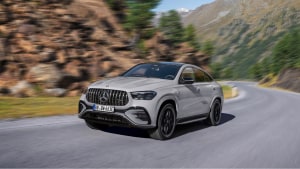2020 Mercedes-Benz G 350d exclusive road test review
First off I'd like to start with a disclaimer, I'm a fanboy of the G-Class, and it is the one vehicle that has eluded me throughout my professional career. I've made several attempts to drive it before this, but it never happened. I've adored it, admired it, lusted after it even, but always from afar, I never ever got to drive it. It is, in my opinion, one of the finest off-road vehicles ever built anywhere in the world. Don't get me wrong, there are better and more capable off-roaders than the G-Class, but less than a handful come close to the luxury, comfort, convenience and everyday usability that the G-Class has to offer. Some of my opinions are therefore shaped by my peers in my team who have driven the previous-gen vehicle and then also this new one.

But I'd never driven one, until now! Mercedes Benz India has finally seen that a market for this breed of vehicles exists in India and they decided to launch it, at a steep Rs 1.5 crore for the base version. That price is, however, a moot point, it's what the G 350d has to offer and how that works for the user that matters most. It is what I set out to discover after all these years waiting for that one time. I am going to try and be as neutral as I can, treating this as any other road test, but if I happen to fawn a little more than necessary, excuse me. I've got stars in my eyes!

Design and style
How do you take a design theme and nearly 40 years later, ensure it stays true to the original outline yet appear modern enough to keep it relevant? In the case of the G-Class, you don't bother, simply because the rugged and raw in-your-face styling was so appealing, no one wanted anything different! For the last four decades, the boxy shape with the slab-sided front face, the upright windscreen, the huge glass surfaces and the flat, sans any contours, roof have all stayed almost like it was originally designed to be. Even the exposed indicators at the front end that sit on top of the fenders, the exposed door hinges and the door handles, these are all remnants of the past that have stayed just the way they always were. Some amount of softening has been done to the edges, without taking away from the original design. This particular generation, which continues to carry the internally designated W463 code, has only grown marginally larger. 12cm in width, 5cm in length and with 6mm more ground clearance. It's also dropped 170 kilos which is huge weight-saving.
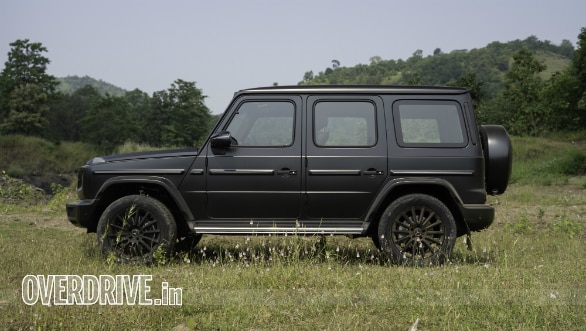
Looking at it you'd assume the G 350d has the aerodynamics of a brick, but it's a brick that can be flung to mind-warping speeds and corner quite impressively! More on that later. It's interesting to note that this is a spectacularly large vehicle, it has the street presence to demolish anything that stands next to it. The only other vehicle that could in the least hold its own against the G 350d would be the Jeep Wrangler. In fact, there was a period in time when Mercedes-Benz was contemplating if they needed the GL-Class at all or if the G-Class would be more than enough.
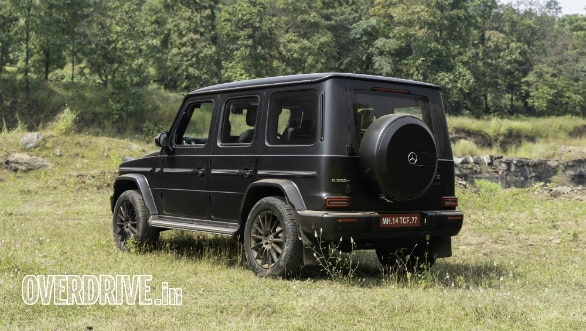
My opinion. I'm a big fan of the 'big butch go-anywhere' utility vehicles, especially the ones that look like they could jog around Mars before breakfast, and not care a damn if a fender or mirror or number plate fell off somewhere along the way! They'd still look good, capable and dependable. I think that is it, the big draw of the G 350d is that it looks capable and dependable anyplace, anytime, while still looking immensely cool. And then there is that matte black paint layered everywhere including those massive, optional 20-inch wheels, that's just a mean, wicked, back-off-biatch black!
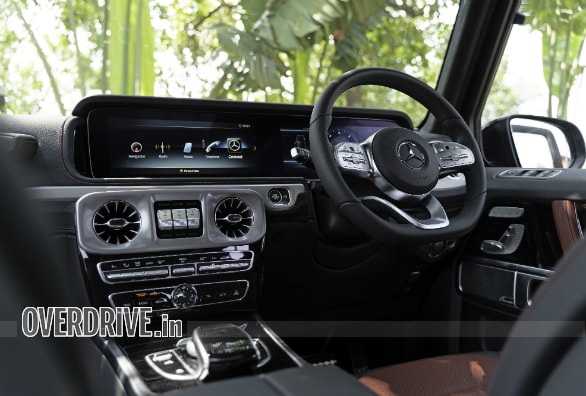
How else do you know the G 350d would survive the apocalypse? Try opening the doors. The heft and sound of those doors opening or shutting is akin to a nuclear survival bunker door opening. Bring on the warheads, you mad despot, the G-Class is my shelter! And what a shelter, this particular media vehicle has been kitted to the 'T', with some of the best equipment that Mercedes can offer its customers. Seats that even massage your ego! The LCD dash display derived from the S-Class. Alacantara, leather, billet aluminium, the list just goes on. It's all tastefully done, except for the seats, I'd have liked them in all black! Mercedes claims that no single G 63 AMG sold in India is the same as any other, and this customisation program carries forward to the G 350d as well. So the base price of Rs 1.5 crore is just an indicator, almost every single G 350d accounted for already costs more than that base price!
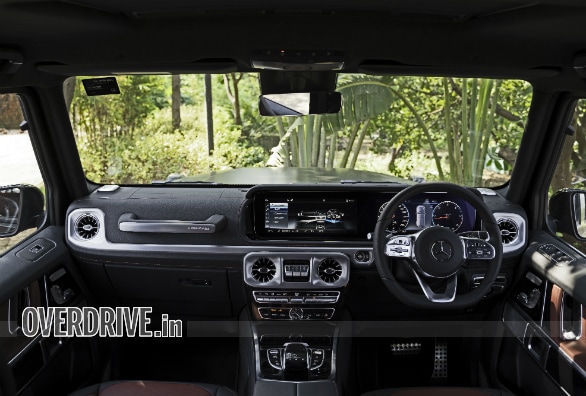
So what is it like to live in? The cabin isn't spartan, it's a busy place and with a commanding view of everything. The stance and the tall expansive seats clearly put the driver in charge, this is your throne in your throne room. The upright windscreen provides fantastic visibility as the A-pillar need not be as thick when the windscreen rake is narrower. The higher seating position also ensures you have a broader view of the surroundings. And the dashboard is narrow, unlike every other contemporary SUV, the G 350d does not need a wide and deep dashboard, so you're sitting closer to the windscreen, all leading up to a commanding view. With the narrower rake and the lack of dashboard area, there are fewer reflections thrown up on the windscreen. This makes the G 350d easy to manoeuvre in urban areas or even when you go off-road. The only area you need to watch out for are the sides, as the fenders stick out quite a bit.

The doors I found need a bit of persuasion to shut on the first go. They are quite heavy and with the exposed latches, they don't shut easily. There is also the story about how the sound of the latches meeting as the door shuts was engineered to make a specific sound. Well, it sounds good, but more often than not, I've had to keep reopening doors to shut them again, as they didn't on the first attempt.
Ingress and egress is also a bit of a challenge, the 241mm ground clearance isn't adjustable so you have a steep climb up into the cabin. There is a running board which acts as a step, but it is still quite a haul up into the cabin.
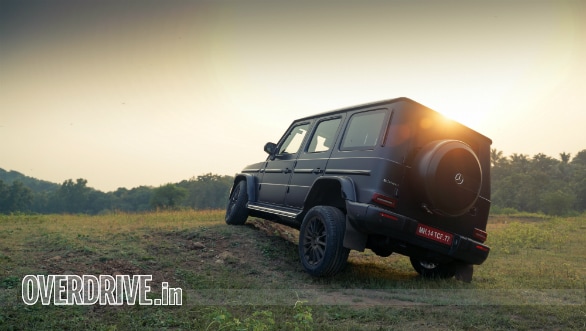
Chassis and suspension
The G-Class is still one of the very few luxury or off-road vehicles available in the world with a body-on-frame chassis. The ladder frame chassis has gone through quite a few changes, significantly lightening and strengthening up. So the hood, the doors and the fenders are all made from aluminium to bring the weight down. Why the ladder frame chassis, instead of moving to a monocoque? Well, the answer thankfully is that Mercedes wanted to retain its off-road prowess for which a ladder frame chassis offers the right amount of torsional rigidity, bending stress and durability. However, the higher centre of gravity in a ladder frame set-up means there is a higher degree of body roll and pitch, not ideal for a vehicle that is capable of touching speeds of 200kmph on-road.
This is where Mercedes-Benz's AMG division came in, giving it the suspension set-up necessary to make it friendlier and safer on-road. So the original front axle was replaced with independent suspension with a double-wishbone front axle. The rear still uses a rigid axle but it's guided by four longitudinal control arms on each side with a Panhard rod to dampen lateral movement.
Then there is the steering system which is completely new. The recirculating ball-type steering used since 1979 has been replaced with an electromechanical rack and pinion system and the changes are very evident. The steering does not feel slow and lazy but is much quicker and responsive. There isn't as much feedback as there used to be on the mechanical system but the new system lends more accuracy and response speed to the G-Class. This improves its dynamic abilities on-road and makes it more agile off it.
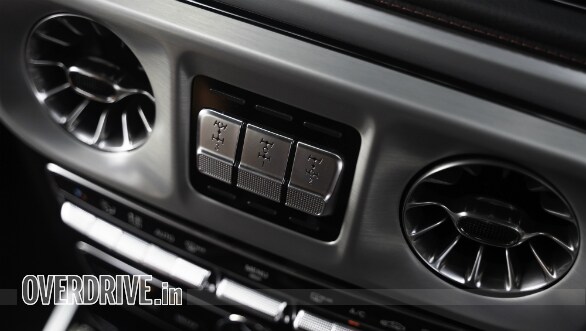
 Â

Far from the tarmac, the G 350d is more in its element. It has multiple differential lock settings for the front axle, the rear or both axles all of which can be selected by flipping on any of the three selector buttons on the dashboard. The suspension travel has been increased slightly, front axle spring/rebound is now 85mm/100mm while at the rear axle, it stands at 82mm/142mm. The raised axles increased ground clearance by 6mm taking it to 241mm which for a vehicle without an adjustable suspension set-up is the best you can get. Compare this to the Jeep Wrangler's Sahara edition that's being sold in India presently, and you'd see the G 350d has almost 10mm more clearance.

Ride and handling
With the ladder frame chassis, you expect the G 350d to be a moderately good vehicle where on-road dynamics are concerned. The high ground clearance, the tall roofline, the high centre of gravity, these amplify its off-road capabilities rather than on-road manners. But that said, the G 350d is stable at reasonable speeds, although that tallish stance and high C of G does make it lean quite a bit when pushed hard into a corner. Having said that, the G 350d will track a sharper line into a corner than most other SUVs, even those with unibody constructions with stiffer suspension set-ups. This character, I believe, is also a virtue of its track to wheelbase ratio (2,890mm/1,638mm) and the optional tyres our test G 350d came with, the 20-inch 275/50 profile Pirelli Scorpion Zeros that are more road-biased and which offer insane levels of grip. And don't expect me to blabber about over or understeer, because that is an absolute waste of time. You want a drive to anywhere on the planet in a comfortable SUV or a sportscar?
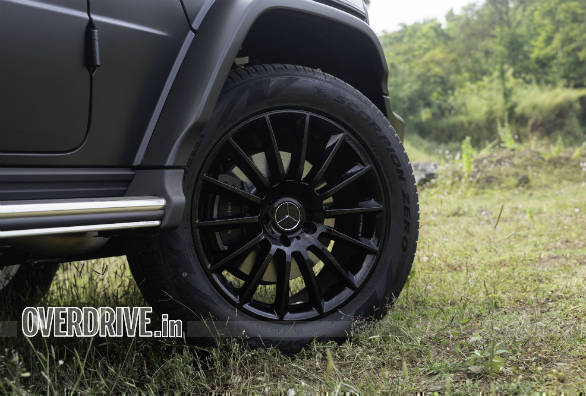
With these tyres, ride quality is also massively, massively impressive. The G 350d ignores potholes, cracks, speed breakers, expansion joints and any other surface deformities like Trump ignores the CNN, NYT and The Washington Post! I expect the base 18-inch tyres would offer even better ride quality. The steering is also precise, well-weighted in both road and off-road conditions and is much more precise compared to the unit of the previous generation.
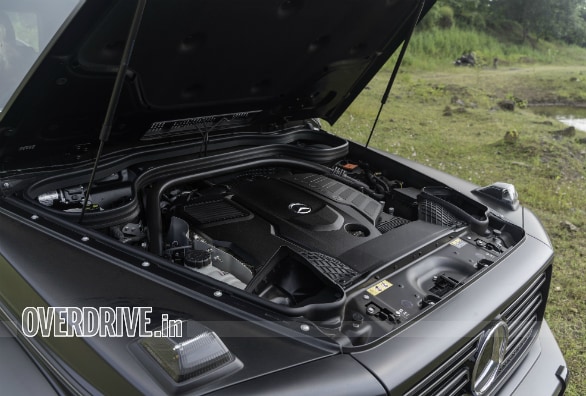
Powertrain and Performance
The G 350d gets the 2,925cc turbocharged in-line 6-cylinder OM 656 engine. It's a mad engine, one we've seen previously in the S-Class. It makes 286PS with 600Nm of peak torque. It also meets Euro 6D-temp regulations already, which means pollutants coming out of its tailpipe are much cleaner than those prescribed by BSVI. This engine can be driven in one of several modes, Eco, Comfort, Sport and Individual. In Eco mode, it has a glide function that disengages the clutch when you step off the throttle, reducing engine speed to idling level. The G 350d then uses its own kinetic energy to coast for a pretty long distance. But, more often than not you're going to be using the throttle given our conditions. And then you have enough grunt to hustle past traffic faster than they or even you expect! You aren't going to want to trim the throttle.

What impressed me more is not the rapidity of those small explosions when you jab the throttle, but the incredible silence when those explosions happen. This is without a doubt one of the quietest diesels I've ever driven, the double glazing lends the G 350d sound refinement of the highest order. Performance is also impressive, bear in mind the G 350d weighs 2,453kg, so putting it into motion isn't going to be easy. And yet, the G 350d on our test clocked 8.4 seconds to a 100kmph, and it stops the speedo needle at 199kmph. You don't need that acceleration and speed, but, it's a nice thought to know you are in possession of such staggering performance.
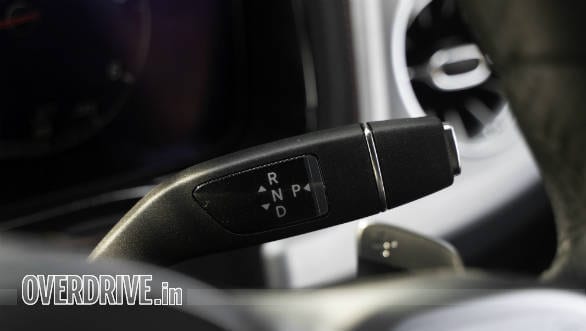
The 9-speed 9G-Tronic automatic transmission is something that Mercedes has been using on almost every other car these days, except for any of the V12-engine models. Shift points change when you slip the G 350d into various drive modes. Gears can also be selected manually with the flappy paddles behind the steering.
The G 350d also gets full-time four-wheel drive with a 60:40 rear to front torque split as default. It also has a low-range ratio which drops the gear ratio from 1.0 in high range to 2.93 in low range which is lower than its predecessors 2.1. This makes it even more capable when trudging through slush or climbing up steeper inclines. And then there is also a 'G-Mode' which the G 350d slips into irrespective of the drive mode you are in whenever you select the diff locks or low ratio.
Coming to efficiency, don't expect much. The G 350d is thirsty, but then you'd be too busy hauling this 2.5-ton beast around. Still, we got at best 13.76kmpl and we managed to extend this to 13.19kmpl with the coast feature. In the urban cycle, the G 350d got 8.88km to the litre.

Verdict
I'm convinced that this, the G 350d is my new goal in life. It looks amazing, drives like a dream and has all the right elements to feed my desires to go overlanding. It is expensive, yes, and those prices are never going to be rationalised. So I'll try the next best thing, Mercedes, can we get one on loan as a long-termer?
----x----
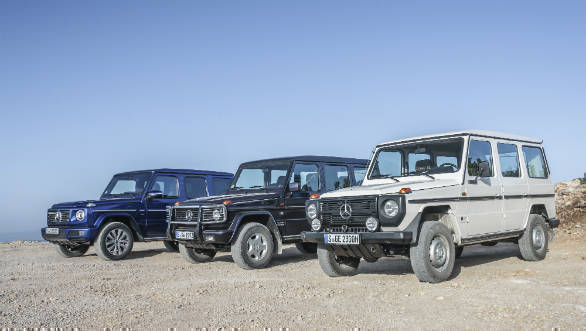
Four Decades at the Top - History of the Mercedes-Benz G-Class
The history of the G-Class harks back to the early 70s when the development of a vehicle (internally known as the 460-series and 461) that could be used by the military was suggested by one of Daimler's biggest shareholder, the Shah of Iran, Reza Pahlavi. He had placed a large order that was later cancelled when he got deposed during the Islamic Revolution. The first military order for the G-Class then came from Argentina, who purchased around a 1,000 of them.
The development that began in 1973 for largely non-civilian use was eventually carried forward to attract more well-heeled customers who got star-struck with the SUV's raw and rugged looks and its off-road prowess that was slowly commanding legendary status across Europe. This led to the 463 series which had better interiors, wood trim, leather seats and ABS.
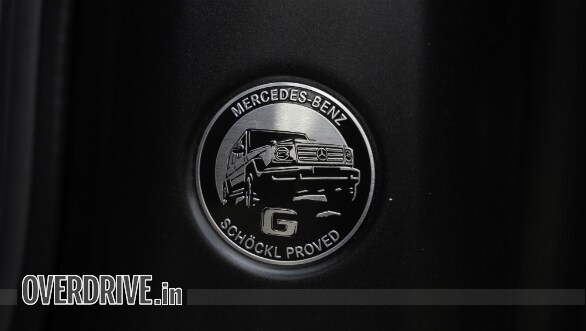
The early G Wagens weren't available in North America, however enterprising dealers found the ways and means to sell them across the Atlantic. Eventually, the sales were banned, but in 2002, Mercedes officially brought the G Wagon to American shores. That ensured it became a hot-selling item, with eventually the AMG versions gaining more popularity and boosting sales for Mercedes. Over time, the G Wagon continued to make waves across the Middle East, which inspired iterations like the 6X6 versions and Asia adding to the numbers.
In India, the AMG version was the first iteration of the G-Class to be rolled out in 2011. It has done brisk business for the company prompting it to offer the more affordable and diesel version, the G 350 d to expand its market share. Word is that Mercedes-Benz India had already got high double-digit orders for the G 350 d, though we are still waiting for it to make it to the second-hand market a few years down the line when I could afford it!
Watch our 2020 Mercedes-Benz G 350d video review below:
Also Read:
2019 Mercedes-Benz G-Class SUV launched in India at Rs 1.5 crore
2019 Mercedes-Benz G-Class SUV India launch â" Live updates: price, specs, features, details
New-gen Mercedes Benz G-Class SUV is here!
Starts Rs 53.9 Lakhs
1995cc
Automatic
268
400
-NA-
Starts Rs 1.5 Crore
2925cc
Automatic
286
600
-NA-


